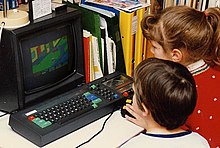Home computer

Home computers were a class of microcomputers that entered the market in 1977 and became common during the 1980s. They were marketed to consumers as affordable and accessible computers that, for the first time, were intended for the use of a single nontechnical user. These computers were a distinct market segment that typically cost much less than business, scientific or engineering-oriented computers of the time such as those running CP/M or the IBM PC, and were generally less powerful in terms of memory and expandability. However, a home computer often had better graphics and sound than contemporary business computers. Their most common uses were playing video games, but they were also regularly used for word processing, doing homework, and programming.
Home computers were usually not electronic kits; home computers were sold already manufactured in stylish metal or plastic enclosures. There were, however, commercial kits like the Sinclair ZX80 which were both home and home-built computers since the purchaser could assemble the unit from a kit.
Advertisements in the popular press for early home computers were rife with possibilities for their practical use in the home, from cataloging recipes to personal finance to home automation, but these were seldom realized in practice. For example, using a typical 1980s home computer as a home automation appliance would require the computer to be kept powered on at all times and dedicated to this task. Personal finance and database use required tedious data entry.
By contrast, advertisements in the specialty computer press often simply listed specifications, assuming a knowledgable user who already had applications in mind. If no packaged software was available for a particular application, the home computer user could program one—provided they had invested the requisite hours to learn computer programming, as well as the idiosyncrasies of their system. Since most systems shipped with the BASIC programming language included on the system ROM, it was easy for users to get started creating their own simple applications. Many users found programming to be a fun and rewarding experience, and an excellent introduction to the world of digital technology.
The line between 'business' and 'home' computer market segments vanished completely once IBM PC compatibles became commonly used in the home, since now both categories of computers typically use the same processor architectures, peripherals, operating systems, and applications. Often the only difference may be the sales outlet through which they are purchased. Another change from the home computer era is that the once-common endeavour of writing one's own software programs has almost vanished from home computer use.
Comments
Post a Comment